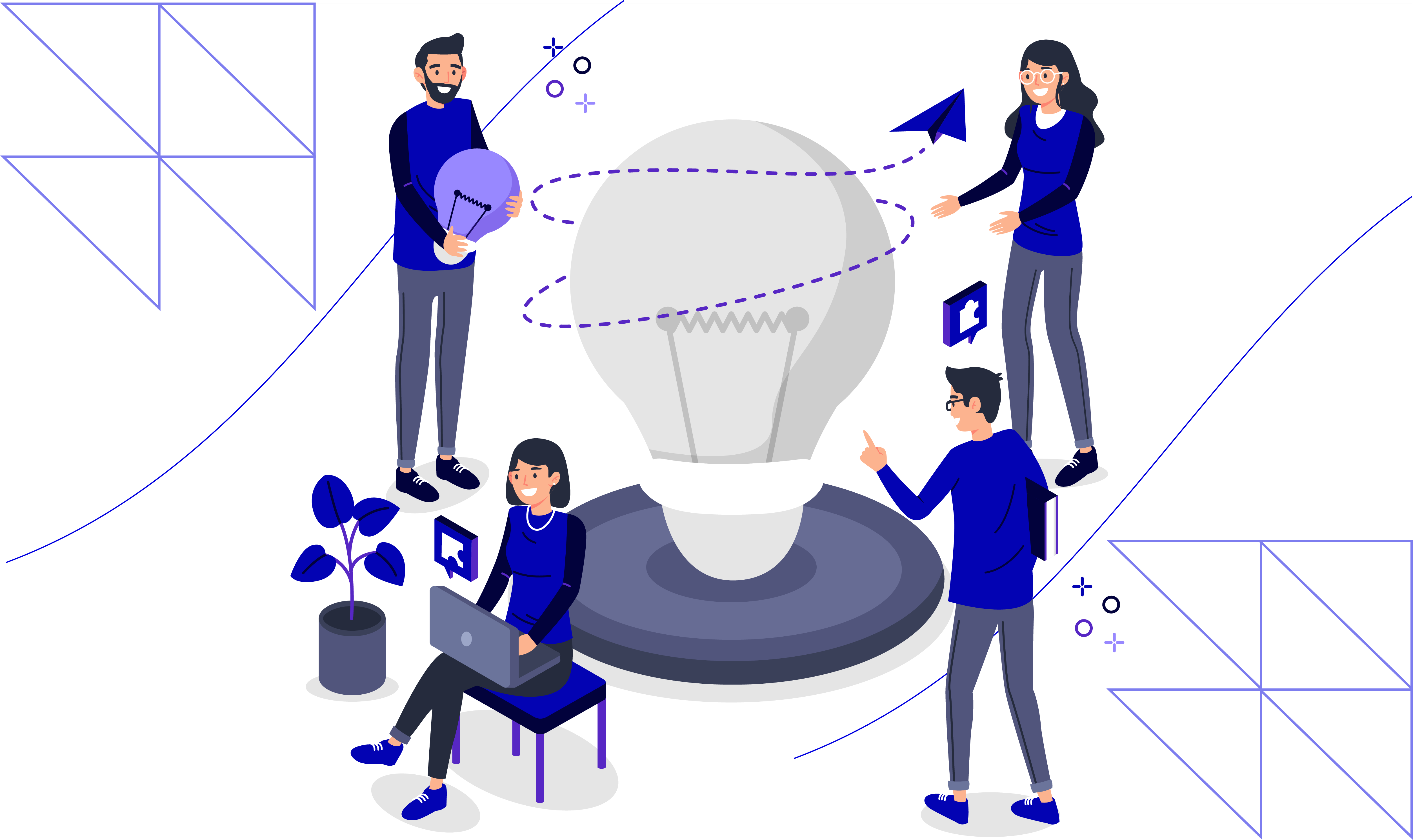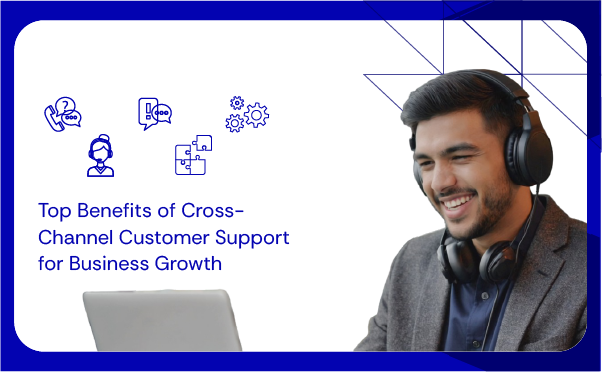What Is Cross-Channel Customer Support?
Cross-channel customer support means offering help on multiple platforms like email, chat, phone, and social media support, making sure everything stays connected. If a customer starts a conversation in live chat, follows up on email, and later calls your support line, they shouldn’t have to explain everything all over again.
Your agents should already know:
- What the issue is
- What’s been done
- What still needs fixing
Now, here’s the key difference between cross-channel and multichannel customer service. With multichannel, you’re available on different platforms, but those platforms don’t talk to each other. The person handling social media doesn’t know what happened over email. The call center rep has no idea the customer already submitted a support ticket. It’s disjointed, exhausting for the customer. With cross-channel, however, everything is connected behind the scenes. No matter how or where the customer reaches out, your team has the full picture. That means faster help, fewer repeat explanations, and a whole lot less frustration.
That’s what customers expect today, as the statistics indicate:
- 88% of customers believe that the experience a business provides them is as important as the products it sells.
- According to Forbes, 71% of customers desire a consistent experience across channels, however just 29% believe they get it.
- 50% of customers are unlikely to do business with a brand that responds slower than they expect.
When you get cross-channel support right, however, customers feel like they’re talking to one brand, not a different team on every channel. That leads to smoother interactions, stronger relationships, and more loyalty. Here are the top benefits that businesses derive from cross-channel customer support.
1. Create a Seamless, Effortless Experience

No one enjoys starting from square one every time they reach out to support. For instance, let’s say you message a brand on Instagram about a late order. A day later, you follow up via outsourced email support services. Then, just to be sure, you hop on live web chat support outsourcing. Now you’ve repeated the same story three times to three different people. Frustrating, right?
This is exactly what cross-channel customer support is designed to fix. When your systems are connected and your teams are synced, here’s what happens instead:
- The agent on live chat already sees your Instagram message.
- They know the status of your order.
- They can pick up the conversation right where it left off, without asking you to “please hold” while they figure things out.
Customers don’t want to know how it works behind the scenes. They just want to feel like your company knows them and cares enough to keep track of their issue.
Cross-channel support makes that happen, resulting in:
- Less back-and-forth
- Quicker resolutions
- Happier, more loyal customers
The simple shift in making support feel connected instead of chaotic is often the difference between a one-time buyer and a lifelong customer.
2. Increase Customer Loyalty by Meeting Them Where They Are

Loyal customers are great because they not only spend up to 67% more than new customers, but also are more likely to refer your business to other customers as well, creating a virtuous cycle of growth. One of the fastest ways to build that kind of loyalty is to be available where your customers already are, and make it easy for them to reach you.
Today’s customers don’t just sit at a desk sending emails or visit stores to resolve their queries. They’re messaging you from their phones while commuting, tweeting questions during lunch breaks, or hopping into live chat while checking out online. That’s where cross-channel customer support really shines. When you’re present on all the right platforms (and keep the experience consistent across them) you build trust. And when customers get that experience, they:
- Feel like you respect their time
- Trust that your brand is dependable
- Become more loyal
3. Improve Response Time and Reduce Repetition

Customers want quick, clear answers without having to repeat themselves. With cross-channel customer support, you get the best of both worlds:
- Faster responses
- Smarter conversations
Here’s how that plays out:
When your support channels are connected, your agents get the full story in front of them, no digging through separate systems, no guessing games. That means your team can:
- Respond faster
- Pick up conversations without asking the same questions
- Resolve issues in fewer steps
And your customers end up feeling like your team is actually on it, not just ticking boxes. And this is a big win for your team, too. Because when agents have the full context, they can stop wasting time toggling between tabs or chasing information. That means:
- Shorter handling times
- Less agent burnout
- Higher productivity
4. Gain Better Data and Smarter Insights

Support teams often sit on a goldmine of data, but it’s buried across disconnected tools, inboxes, and spreadsheets. With cross-channel customer support, that all changes. When your support ecosystem is connected, so is your data. Every customer interaction feeds into a single, unified system. And that means you can finally see the big picture.
Here’s what that unlocks:
- You know which channels your customers use most
- You can track which touchpoints cause drop-offs
- You spot patterns in complaints, questions, or feedback
- You measure team performance with context
Suddenly, customer support ends up shaping product decisions, fueling marketing insights, and driving growth strategy. That’s the power of data, and cross-channel support gives you access to it in real time.
5. Scale Support Without Losing the Personal Touch

Here’s the challenge that every growing business runs into: You want to serve more customers, but you don’t want your support to feel robotic, slow, or impersonal as you scale. That’s where cross-channel customer support really proves its value.
It gives you the systems to handle more volume without sacrificing the human connection your customers love. How?
- You automate the right things: Simple and repeatable tasks like order status updates, password resets, appointment confirmations get handled by AI-powered tools and automated responses, freeing up your team for higher-touch interactions.
- You personalise the moments that matter: Because your support tools are connected, your agents have the full history of each customer (what they’ve bought, where they’ve reached out before, what they’ve asked). That means they can respond like someone who knows the customer, not just another name in the queue.
- You can serve more customers without stretching your team thin: Instead of hiring new agents every time your volume spikes, you use smarter workflows and cross-channel tools that route issues to the right person, reduce duplication, and solve problems faster.
6. Turn Support Into a Revenue Driver, Not Just a Cost Center

Support isn’t just about solving problems. It’s also one of the most powerful growth levers in your business. When your support is cross-channel, connected, and customer-aware, every interaction becomes an opportunity to:
- Upsell the right product at the right time: A customer asking about a feature? Your agent can see their full history and suggest the next best upgrade, without it feeling pushy.
- Reduce churn: You catch frustration early through real-time feedback and sentiment analysis, before it turns into a cancellation.
- Turn complaints into loyalty: Handle a tough situation gracefully across channels, and you can possibly earn lifelong trust. In fact, studies show that it costs 5-7x as much to acquire a new customer than it does to retain an existing customer.
- Gather product and market intelligence: The patterns in your support conversations can shape everything from product roadmaps to marketing messages.
Build a Support Experience That Grows With You

Your customers don’t care what platform they’re on. They don’t think in terms of channels. Instead, what they’re concerned about is questions like:
- “Can I get help now?”
- “Will someone understand what I need?”
- “Do I have to explain this all over again?”
Cross-channel customer support is your answer to all of that. It’s all about making those channels feel like one smooth, connected conversation. And when that happens?
- Customers feel seen and supported
- Your team gets more done with less friction
- Your business builds trust, and grows faster because of it
If you want to build a connected cross-channel customer support system for your business, but need help setting it all up, that’s where Atidiv comes in. Our team of customer experience specialists works with with growth-focused companies like yours to:
- Untangle messy support workflows
- Connect your channels for a seamless omnichannel customer experiences
- Empower your team with the context they need to respond faster and better
- And build a cross-channel communication strategy that actually works in the real world
Let’s talk about how to make your support experience smoother, smarter, and scalable, without losing the human touch that makes your brand unforgettable. Partner with Atidiv to scale smarter.
FAQs On Cross-Channel Customer Support
1. What is cross-channel customer support?
Cross-channel customer support is when you offer service on multiple platforms like email, chat, social, and phone but keep the experience connected. Customers can switch channels without starting over, and your team has the full context across every touchpoint.
2. How is cross-channel support different from multichannel customer service?
Multichannel customer service means you’re available on several platforms, but those platforms don’t always talk to each other. Cross-channel support goes a step further by connecting those interactions into one seamless conversation, so customers don’t have to repeat themselves.
3. Why is a cross-channel communication strategy important for business growth?
A smart cross-channel communication strategy helps your business deliver faster, more consistent service. It reduces friction, boosts satisfaction, and increases customer loyalty, all of which lead to better retention and long-term growth.
4. Can cross-channel support help increase customer loyalty?
Absolutely. When customers can reach you how and when they want, and don’t have to start over each time, they’re more likely to trust and stick with your brand. Cross-channel support makes them feel seen, heard, and valued.
5. What tools do I need to implement cross-channel customer support?
You’ll need a support platform that unifies channels (such as Zendesk, Freshdesk, or Intercom), along with CRM integration and shared inboxes. The goal is to create one connected view of the customer across your team, no matter where they reach out from.

